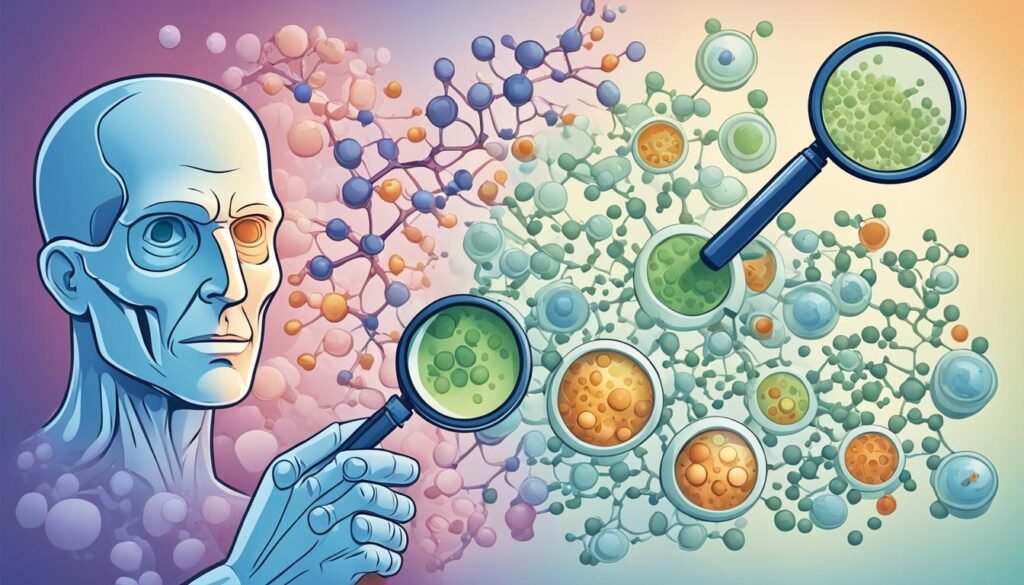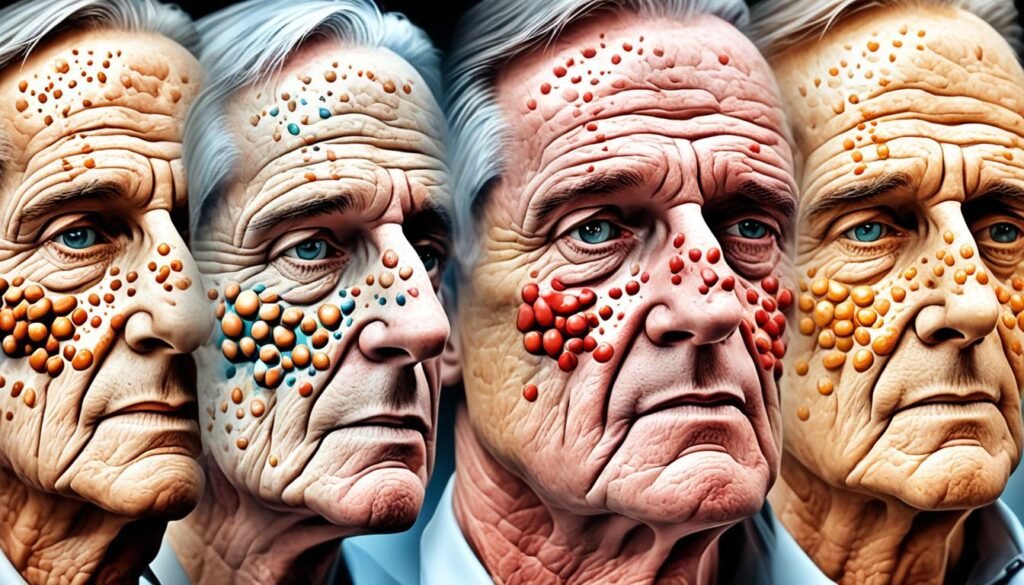Neurofibromatosis is a group of three genetic disorders leading to nerve tumors. These types include neurofibromatosis type 1 (NF1), neurofibromatosis type 2 (NF2), and schwannomatosis. NF1, the most common, occurs in 1 out of 2,500 people. NF2 affects fewer people, 1 in 40,000. Schwannomatosis is very rare, seen in 1 out of 40,000 individuals. The range of symptoms of neurofibromatosis is broad, from light skin changes to complex issues. Knowing about each type helps in managing this condition.
Table of Contents
ToggleOverview of Neurofibromatosis
Neurofibromatosis is a set of genetic issues. It makes tumors grow on nerves all over the body. There are three main types: neurofibromatosis type 1 (NF1), type 2 (NF2), and schwannomatosis. It’s key to know the differences for treating these conditions well.
What is Neurofibromatosis Type 1 (NF1)?
NF1 is the most common form, found in about 1 in 2,500 people. It changes the color of skin and causes tumors on nerve tissue. The gene mutation for NF1 is on chromosome 17. It’s inherited in an autosomal dominant way. This means each child of a parent with NF1 has 50% odds of getting the gene.
What is Neurofibromatosis Type 2 (NF2)?
NF2 is less common, seen in about 1 in 40,000 folks. It creates noncancerous tumors on nerves affecting hearing and balance. This often leads to issues with both hearing and balance.
Schwannomatosis: A Related Disorder
Schwannomatosis causes noncancerous tumors on nerves and is less common still. It affects an estimated 1 in 40,000 people. Like the other types, it’s due to genetic mutations. These mutations make cells grow uncontrollably, forming tumors.

Symptoms of Neurofibromatosis Types
The symptoms of neurofibromatosis look different in everyone. It’s key to know the specific signs for each type. This helps doctors diagnose and treat this genetic condition better.
Common Symptoms in NF1
Neurofibromatosis type 1 (NF1) shows itself in many ways. People with NF1 might have light brown spots on their skin, like café-au-lait spots. Besides, they could have bumps on their skin, known as neurofibromas, and show some bone issues.
Kids with NF1 might have a large head and be shorter than usual. Finding these signs early helps with the right care.
Symptoms of NF2
Neurofibromatosis type 2 (NF2) mainly affects the nerves that help with hearing and balance. It brings about benign tumors. These tumors, vestibular schwannomas, can lead to hearing loss and trouble with balance. Because of this, regular check-ups are vital to watch for complications.
Signs of Schwannomatosis
Schwannomatosis causes the noncancerous tumors called schwannomas on nerves outside the brain. These tumors often cause long-term pain. They can impact someone’s life greatly. This disorder is different from NF1 and NF2 in its symptoms and causes.
The severity of neurofibromatosis symptoms varies widely, even for those with the same type. Some may have very mild signs, while others face serious health issues. Regular doctor visits and early action are crucial for dealing with this condition.

Neurofibromatosis type Causes and Risk Factors
Neurofibromatosis starts when our genes change. This change messes with how our cells grow. NF1 changes the NF1 gene, lowering cell growth control with less neurofibromin protein. NF2’s NF2 gene mutation means less merlin protein, affecting cell growth regulation. Schwannomatosis changes come from errors in the SMARCB1 and LZTR1 genes.
Neurofibromatosis spreads in an “autosomal dominant” way. If a parent has it, their child might get it. They have a 50% chance of getting the problem-making gene. Sometimes, NF1 happens in a family with no past cases.

Genetic Causes of NF1
For NF1, a NF1 gene mistake causes little neurofibromin protein, leading to tumor growth. 30 to 50% of NF1 cases start from a new gene mistake.
Genetic Causes of NF2
NF2 is linked to NF2 gene issues, affecting merlin’s job in limiting tumor grow. Half of NF2 cases are from a parent. But, many cases start fresh without a family link.
Autosomal Dominant Inheritance Pattern
How NF1 and NF2 spread is called “autosomal dominant.” It needs one gene change to show up. Yet, 85% of schwannomatosis cases have no known gene issue.
Having a family with neurofibromatosis raises your risks too. Yet, it can happen even without a family history. This condition leads to problems like losing your hearing, never-ending pain, and a higher chance of getting some cancers.
Diagnosis and Diagnostic Criteria
Diagnosing neurofibromatosis usually involves looking at specific signs. For NF1, doctors check if a person has some key features. These include spots like birthmarks, and freckles in certain areas. They also look for lumps under the skin, tumors on the nerve of the eye, small bumps in the iris, suspicious bone growth, and a family history.
Diagnostic Criteria for NF1
The National Institutes of Health set the rules for diagnosing NF1. They look for things like the coffee-colored spots and skin bumps. Also, lumps under the skin, eye nerve tumors, eye spot bumps, odd bone growth, and family connections help determine a diagnosis. By the age of eight, about 97 percent of people are identified with NF1 based on these signs.
Diagnostic Criteria for NF2
For NF2, doctors check for specific types of tumors. If someone has a tumor on both nerves for hearing and balance, it’s a sign. Or, if a close family member has NF2, and the person has a tumor on one hearing and balance nerve or other specific tumors, it helps in the diagnosis. MRI scans are usually needed to spot these tumors.
Diagnostic Criteria for Schwannomatosis
Schwannomatosis is diagnosed when someone has at least two of the same type of tumors. Doctors also must rule out other conditions by checking for specific gene changes. A blood test can confirm NF2 in many cases. But, sometimes, even when a test is negative, the disease could still be schwannomatosis.

Treatment and Management Options
While there’s no cure for neurofibromatosis, there are treatment and management options. These help patients deal with symptoms and prevent or treat complications. How treatment is approached depends on the type of neurofibromatosis and the person’s needs.
Treatment for Children with NF1
Kids with NF1 need regular check-ups and close symptom monitoring. For any developmental or learning issues, early action is key. Medications can help with symptoms like ADHD or seizures. Surgery might be needed to address larger or symptomatic tumors.
Treatment for Adults with NF1
For adults with NF1, yearly check-ups are important. They should closely watch for certain problems like scoliosis and cancer. Medications and surgery can help manage and address symptoms, with a focus on improving life quality.
Management of NF2 and Schwannomatosis
People with NF2 or schwannomatosis often need MRI scans to watch tumor growth. Treatment might include surgery, radiation, or targeted drugs. The plan is based on tumor size and location, plus the individual’s health and symptoms.
The main goal for treating and managing all forms of neurofibromatosis is to help patients live better lives. This involves regular check-ups, early intervention, and support services for those dealing with this genetic condition.
Complications of Neurofibromatosis
Neurofibromatosis can bring many issues, from learning disabilities to attention problems and seizures. It also includes skeletal issues like scoliosis and brittle bones. People with it may have vision and hearing issues, high blood pressure, and a higher cancer risk.
Most growths from neurofibromatosis are noncancerous, but some turn cancerous. The effects can range from minor to serious. Regular medical checkups are vital to stay on top of the condition.
Those with neurofibromatosis have a bigger chance of getting cancer. This includes cancers of the breast, blood, colon, brain, and soft tissues. Brain tumors affecting 15% with NF1 are also seen, with different types such as astrocytoma and optic pathway glioma.
About 65% of people with NF face learning problems and ADHD. Early help with learning and educational support is key. Conditions like scoliosis and frail bones need watchful care too.
Many experience only mild symptoms needing no treatment. But, the risk of severe issues means staying on top of your health is crucial. Good medical care and regular checks can help manage the condition and improve life quality.
Incidence and Prevalence
Neurofibromatosis is a rare genetic disorder. It has different types with varying rates. NF1 is the most common, with about 1 in 2,500 people affected. The studies screening for NF1 found it in 1 in 2,020. However, medical records showed a lower rate, 1 in 4,329.
On the other hand, NF2 is less common, affecting around 1 in 40,000. Schwannomatosis is the rarest, hitting 1 in 40,000. This shows their rarity compared to NF1.
NF1’s birth incidence is noteworthy, at 1 in 2,662. Its prevalence, however, is even higher, at 1 in 3,164. This means many more people might have it than those born with it.
The disorder passes from parents to children with a 50% chance. Yet, in half the cases, the mutation happens without a family history.
Resources for Neurofibromatosis Support
If you or someone you care about has been diagnosed with neurofibromatosis, there’s help and education available. One key place to start is the Children’s Tumor Foundation. They work hard to fight this disease through research and spreading awareness. Another great resource is the Neurofibromatosis Network. They offer tons of support, education, and information for those affected.
If you specifically have Neurofibromatosis Type 2 (NF2) or schwannomatosis, check out the Acoustic Neuroma Association and the British Columbia Neurofibromatosis Foundation. They provide focused help and link you with experts and support groups. They make it easier to handle the unique issues these conditions bring.
There are also big medical places like Harvard Medical School and Johns Hopkins Hospital that offer support for those with neurofibromatosis. They share many resources, from learning about the disease and clinical trials to dealing with its genetic aspects. They also help with financial needs, offer government resources, and support mental health and hearing issues.
The Neurofibromatosis Midwest is a great organization too. You can find lots of info about clinics, awareness campaigns, and the latest research. They provide educational help and support services for those with neurofibromatosis. The National Cancer Institute, National Institutes of Health, and American Brain Tumor Association are also crucial support sources for patients and their families.
Conclusion
Neurofibromatosis is a genetic disorder with three main types. These are NF1, NF2, and schwannomatosis. Each type has its own symptoms and causes. Knowing about them helps manage the disease better.
People with neurofibromatosis should get checked often by a doctor. It’s also important to start treatment early. Having support helps both the affected person and their family.
Better treatment and understanding of neurofibromatosis give hope. The community is working hard to improve care. They hope to make life better for those with this condition.
Healthcare pros, researchers, and support groups are teaming up. They want to offer the best care. Staying informed and managing the disease is key. This helps people and their families face the challenge with strength.
FAQ
What is neurofibromatosis and what are its main types?
Neurofibromatosis refers to three genetic disorders. They cause tumors on nerves. The main types are NF1, NF2, and schwannomatosis.
What are the symptoms of the different types of neurofibromatosis?
NF1 causes light brown skin spots, freckles in armpits and groin, and small skin bumps. It also leads to bone issues. NF2 results in hearing and balance problems due to tumors on nerve controls. Schwannomatosis causes chronic pain from nerve tumors.
What causes neurofibromatosis?
Genetic mutations affecting proteins that control cell growth are behind neurofibromatosis. NF1 links to mutations in the NF1 gene. NF2 links to NF2 gene mutations. Schwannomatosis usually involves mutations in the SMARCB1 and LZTR1 genes.
How is neurofibromatosis diagnosed?
Diagnosis is based on certain signs. NF1 includes café-au-lait spots and neurofibromas. NF2 needs vestibular schwannomas or certain symptoms. Schwannomatosis is diagnosed with two or more schwannomas and no NF2 gene mutations.
What are the treatment and management options for neurofibromatosis?
Even though there’s no cure, management options exist. For NF1 children, regular check-ups and early actions are key. Medications and surgeries can help. Adults with NF1 need annual checks. People with NF2 or schwannomatosis might need surgeries, radiation, or MRI scans.
What are the potential complications of neurofibromatosis?
Neurofibromatosis can lead to various problems. These include nerve, bone, vision, and heart issues. There’s also a small risk of certain cancers.
What is the incidence and prevalence of neurofibromatosis?
NF1 is common, affecting about 1 in 2,500 people. NF2 is less common, affecting roughly 1 in 40,000. Schwannomatosis is the rarest, also affecting 1 in 40,000.
What resources are available for individuals and families affected by neurofibromatosis?
Several groups offer support, including the Children’s Tumor Foundation and the Neurofibromatosis Network. They provide help, education, and resources for those with neurofibromatosis.
Source Links
- https://www.aans.org/en/Patients/Neurosurgical-Conditions-and-Treatments/Neurofibromatosis
- https://www.ncbi.nlm.nih.gov/books/NBK459329/
- https://medlineplus.gov/genetics/condition/neurofibromatosis-type-1/
- https://www.ninds.nih.gov/health-information/disorders/neurofibromatosis
- https://nyulangone.org/conditions/neurofibromatosis/diagnosis
- https://www.ncbi.nlm.nih.gov/pmc/articles/PMC8354850/
- https://www.hopkinsmedicine.org/health/conditions-and-diseases/neurofibromatosis/neurofibromatosis-type-1
About The Author

This article is medically reviewed by Dr. Chandril Chugh, Board-Certified Neurologist, providing expert insights and reliable health information.
Dr. Chandril Chugh is a U.S.-trained neurologist with over a decade of experience. Known for his compassionate care, he specializes in treating neurological conditions such as migraines, epilepsy, and Parkinson’s disease. Dr. Chugh is highly regarded for his patient-centered approach and dedication to providing personalized care.
→ Book a consultation to discover which remedies suit your needs best.




